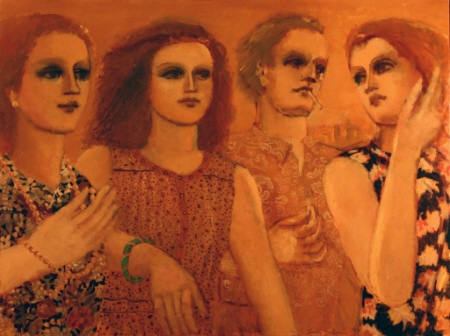The label below will be present in the exhibition alongside this piece. It is provided here so that fans submitting fanworks know in advance how fandom will be discussed in this project. However, fanworks do not need to take into account the below information and should be inspired by or responding to the piece of art alone:
Lester Johnson
American, 1919 - 2010
Classical Group #4, 1985
Oil on canvas
36 x 48 in
2004.15.1
Gift of Allen and Vicki Samson
New York artist Lester Johnson, a second-generation Abstract Expressionist, created oversized paintings filled with recognizable objects and figures. The use of recognizable subjects was especially radical in an adamantly pro-abstract-expressionist climate. Sculptor George Segal recalled: "The Abstract Expressionists were legislating any reference to the physical world totally out of art. This was outrageous to us." Rebellion came naturally to Lester Johnson, and he remained tenaciously outside the mainstream. Today, Johnson’s combination of Abstract Expressionist technique and recognizable subjects means that his work holds significance for both abstract and figurative artists.
Politics/Social Movements
Fan communities engage in collective behavior to affect change. Sometimes, this change is directly related to the fandom—as is the case when fans of a canceled show band together to compel media creators and owners to continue the production of new episodes. Fans may also use their communities to affect change outside of that directly related to the fandom, by creating fundraisers, rallying around political figures, or using imagery related to the fandom in conjunction with imagery relating to specific social causes. Media creators and owners connected to the fandom may approve of, promote, or even initiate these political and social campaigns, as they can provide inexpensive marketing opportunities. However, if the cause is controversial, there may be an attempt to reduce or restrict collective fan behavior.
Subscribe to RSS Feed (Opens in New Window)
| 2024 | ||
| Thursday, August 22nd | ||
| 12:00 AM |
Amanda Plumb "Classical Group #4" (political and social movements) 12:00 AM - 12:00 AM |
|
|---|---|---|
| 12:00 AM |
Damon Wellner "Classical Group #4" (political and social movements) 12:00 AM - 12:00 AM |
|
| 12:00 AM |
Angie Price "Classical Group #4" (political and social movements) 12:00 AM - 12:00 AM |
|
| 12:00 AM |
Super Graphic Ultra Modern Girl Holly Wood "Classical Group #4" (political and social movements) 12:00 AM - 12:00 AM |
|
| 12:00 AM |
Patrick Coover "Classical Group #4" (political and social movements) 12:00 AM - 12:00 AM |
|
| Friday, August 23rd | ||
| 12:00 AM |
Fulcrum.Actual "Classical Group #4" (political and social movements) 12:00 AM - 12:00 AM |
|
